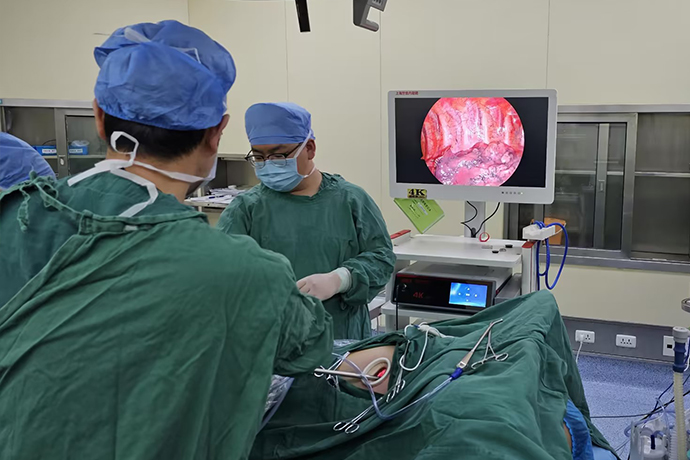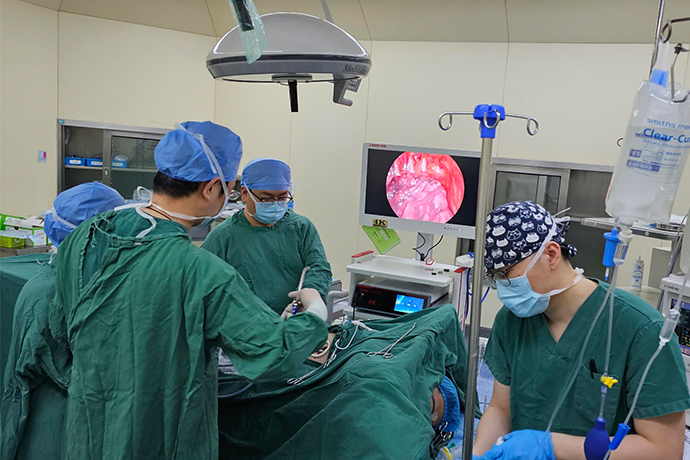[Thoracoscopic surgery of thoracic surgery] 4K ultra-high-definition thoracoscopy for lung cancer resection at the posterior apex of the left upper lung
Release time: 05 Dec 2023 Author:Shrek
Data show that lung cancer is the malignant tumor with the highest incidence rate in men and the second highest incidence rate in women in my country. It is also the malignant tumor with the highest mortality rate in both men and women, posing a huge threat to people's health in our country. With the gradual popularization of the concept of physical examination, some people's CT shows that there are nodules in the lungs and require surgery. But how to choose the method of surgery?

01.
Traditional surgical methods for lung cancer and their disadvantages:
1. Traditional lung cancer surgery usually involves an incision in the lumbar chest. The incision is often 25-30cm long. Sometimes it may be necessary to cut off 1-2 ribs. The patient is very traumatic and faces considerable pain during and after the operation. risk.
2. Surgery often takes about 10 days to leave the hospital, and the recovery period is long.
3. Even if the operation is successful and the patient recovers well and is discharged from the hospital, the quality of life after the operation will be relatively poor, with year-round chest pain and even lifelong pain. Sometimes, there will also be problems with upper limb dysfunction on the side where the operation was performed. It is difficult to perform some of the simplest activities such as washing your face and combing your hair, and you gradually lose your ability to take care of yourself.
02.
Minimally invasive surgery for lung cancer and its advantages:
Unlike traditional surgeries, which often require incisions of twenty to thirty centimeters, thoracoscopic surgery only requires one or more incisions of about 3cm. The thoracoscope can enter through this small incision, allowing the internal structure to be seen at a glance, and Along with the thoracoscope, there are some operating instruments that go in through the incision. These instruments can be operated by doctors or robots to accurately remove the diseased area. Basically, as long as the tumor is not particularly large, all traditional lung cancer surgeries can be performed in a minimally invasive manner with the help of thoracoscopy. Compared with traditional surgical methods, thoracoscopic surgery has the advantages of fast recovery, fewer complications, good or even better curative effect, and high quality of life after surgery.
03.
What types of lung cancer can be treated with minimally invasive surgery?
Lung cancer is divided into small cell lung cancer and non-small cell lung cancer. Small cell lung cancer is common in male patients and is the most malignant type of lung cancer. It proliferates quickly and may metastasize at an early stage. Clinical treatment of small cell lung cancer Mainly radiotherapy and chemotherapy, surgical treatment is not effective; non-small cell lung cancer can be divided into squamous cell carcinoma, adenocarcinoma and large cell carcinoma. Among them, squamous cell carcinoma and large cell carcinoma have good surgical effects and are suitable for minimally invasive surgery. treat. Generally speaking, early-stage lung cancer can achieve good therapeutic effects and even be cured through minimally invasive surgery.
04.
Types of minimally invasive surgery
Thoracoscopic minimally invasive surgery: 4-hole, 3-hole, 2-hole, single-hole minimally invasive and multi-hole minimally invasive surgeries are all optional surgical approaches in minimally invasive lung surgery. Surgeons should choose according to their own habits, patient's condition or For other special circumstances, different surgical approaches should be chosen instead of sticking to one. All choices should be based on the patient's safety and the principle of complete tumor resection.
The lungs are divided into two parts: the right lung has upper, middle and lower lobes, and the left lung has upper and lower lobes. Each lung lobe is composed of 2-5 lung segments, with a total of 10 lung segments on the right side and 8 lung segments on the left side.
Pneumonectomy is an effective means to treat benign and malignant tumors in the lungs or bronchus, as well as bronchiectasis and other diseases. Depending on the nature and scope of the lesion and the patient's lung function, different resection methods can be selected.
Taking lung segments as units, the lung function proportions of each lung segment are roughly as follows:
Left upper lobe
Right upper lobe
Post-apical segment: 6%
Apical segment: 6.9%
Front section: 6%
Back section: 6.9%
Upper lingual segment: 4.3%
Anterior segment: 6.9%
Hypolingual segment: 4.3%
right middle lobe
Left lower lobe lateral segment: 4.5%
Dorsal segment: 6.1%
Medial segment: 4.5%
Medial anterior basal segment: 6.1% right lower lobe
External basal segment: 6.1%
Dorsal segment: 4.9%
Posterior basal segment: 6.1%
Inner basal segment: 4.9%
Anterior basal segment: 4.9%
*Left lung: 2 lobes, 8 segments, outer basal segment: 4.9%
*Right lung: 3 lobes, 10 segments, posterior basal segment: 4.9%
Pulmonary function index FEV1 segmentectomy lobectomy
Decreased by 10.4% and decreased by 13.1% in 6 months after operation
Decreased by 8.5% and decreased by 12.0% 1 year after operation
Therefore, segmentectomy preserves lung function better than lobectomy.
However, due to the lack of obvious anatomical gaps and unclear boundaries between lung segments, it is difficult to peel off lung segments, and adjacent lung tissue is easily damaged. The incidence of postoperative complications such as air leakage is relatively high. Therefore, the indications for segmentectomy should be judged carefully.
Although thoracoscopic surgery is said to be less invasive to the patient's body, it will still cause some damage to the body, and there are many things that need to be paid attention to after the surgery.

- Recommended news
- 【General Surgery Laparoscopy】Cholecystectomy
- Surgery Steps of Hysteroscopy for Intrauterine Adhesion
- [Gynecological Hysteroscopy] Techniques for Preventing and Treating Complications of Hysteroscopic Surgery
- [Gynecological Hysteroscopy] Hysteroscopic Adhesiolysis
- [Gynecological Hysteroscopy] IUD Removal under Hysteroscopy